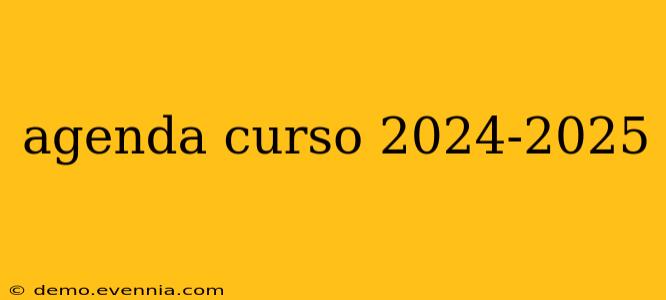Agenda Curso 2024-2025: A Comprehensive Guide for Students and Educators
The 2024-2025 academic year is fast approaching, and with it comes the need for a well-structured and engaging curriculum. This guide will help students and educators alike navigate the upcoming school year by providing a framework for creating a successful and enriching learning experience. We'll explore key aspects of creating a comprehensive agenda curso 2024-2025, focusing on planning, implementation, and assessment.
I. Planning the Agenda Curso 2024-2025: Key Considerations
Before diving into the specifics of each subject, it's crucial to lay a solid foundation for the entire academic year. This involves several key steps:
-
Curriculum Alignment: Ensure the agenda curso aligns with national or regional educational standards and learning objectives. This ensures students acquire the necessary skills and knowledge within the stipulated timeframe.
-
Student Needs Assessment: Understand the diverse learning styles and needs of your students. This may involve pre-assessments or discussions to tailor the curriculum and teaching methodologies effectively.
-
Resource Allocation: Secure necessary resources, including textbooks, technology, and teaching materials, well in advance to avoid disruptions during the academic year.
-
Time Management: Create a realistic and achievable timetable. Avoid overpacking the schedule, leaving room for flexibility and unforeseen circumstances.
II. Structuring the Agenda Curso 2024-2025 by Subject
The specific content will depend on the subject and grade level. However, a general framework could include:
-
Specific Learning Objectives: Clearly define what students should achieve by the end of each unit or term. This should be measurable and observable.
-
Topic Breakdown: Divide the subject matter into manageable units, sequencing them logically for optimal understanding.
-
Activities and Assessments: Incorporate a variety of engaging activities, including hands-on projects, group work, presentations, and individual assignments. Include a mix of formative (ongoing) and summative (end-of-unit/term) assessments to track student progress.
-
Technological Integration: Explore opportunities to integrate technology effectively to enhance learning and engagement. This could involve using educational software, online resources, or collaborative digital platforms.
III. Example Agenda Curso Structure (Illustrative)
To illustrate, let's consider a hypothetical example for a secondary school Spanish course:
Trimestre 1:
-
Weeks 1-4: Basic Grammar – Present Tense, Greetings, Introductions. Activities: Interactive games, role-playing, vocabulary building exercises. Assessment: Quiz on grammar and vocabulary.
-
Weeks 5-8: Describing People and Places. Activities: Picture descriptions, creating short stories, presentations. Assessment: Written assignment describing a place.
-
Weeks 9-12: Simple Conversation Practice. Activities: Pair work dialogues, simulated conversations, short videos. Assessment: Oral presentation on a chosen topic.
Trimestre 2 & 3 would follow a similar structure, building upon the foundation established in the first trimester.
IV. Implementing and Assessing the Agenda Curso 2024-2025
Successful implementation requires ongoing monitoring and adaptation. This involves:
-
Regular Feedback: Gather feedback from students and colleagues to identify areas for improvement.
-
Flexibility: Be prepared to adjust the agenda based on student needs and progress.
-
Data Analysis: Regularly analyze assessment data to track student progress and identify learning gaps.
By focusing on careful planning, effective implementation, and ongoing evaluation, educators can create a rich and engaging agenda curso 2024-2025 that prepares students for success. Remember that the key is to create a dynamic and responsive learning environment that caters to the diverse needs of all learners. A well-structured agenda is crucial, but flexibility and adaptability are just as vital for a successful academic year.

